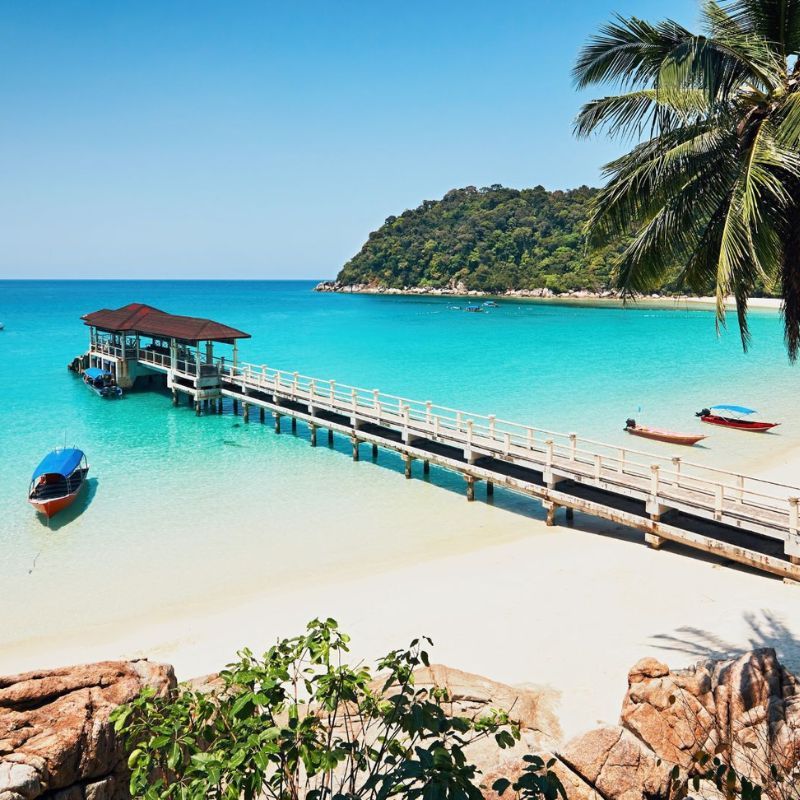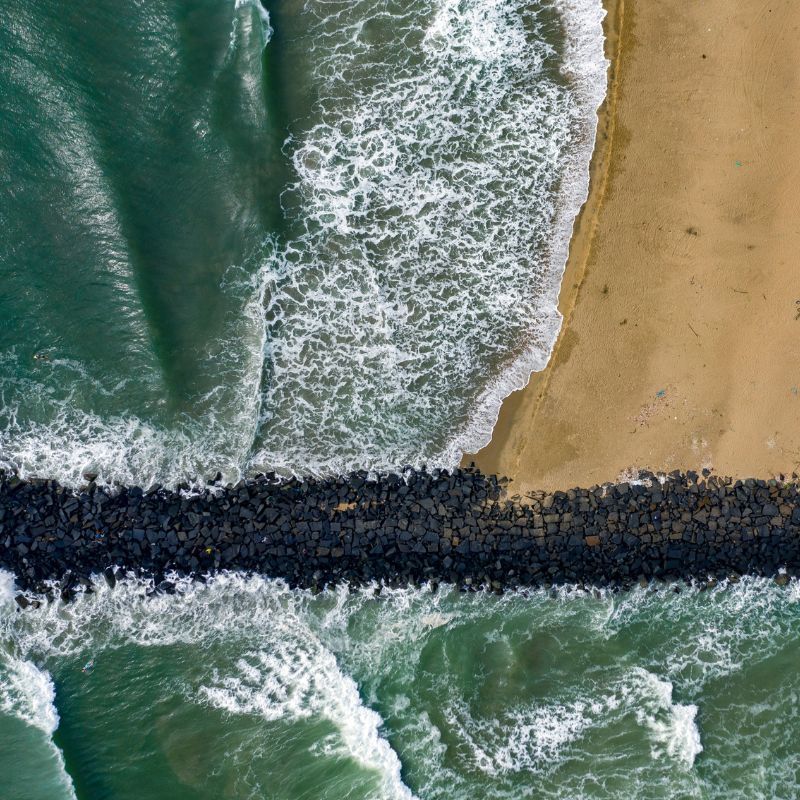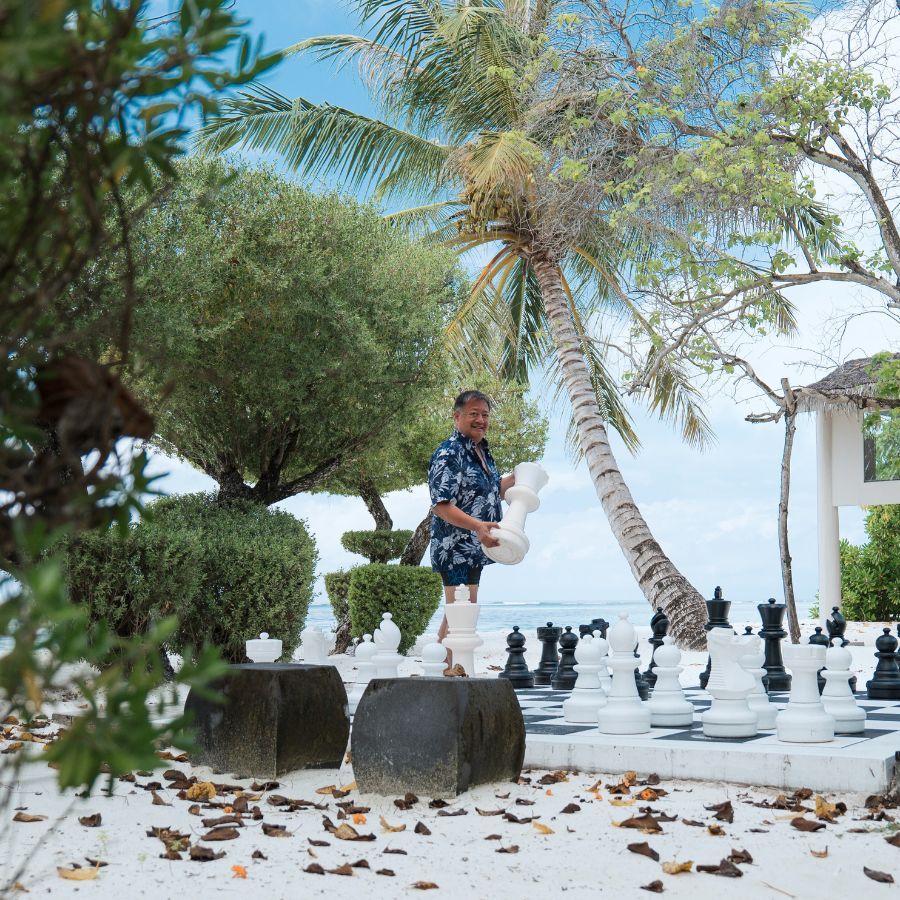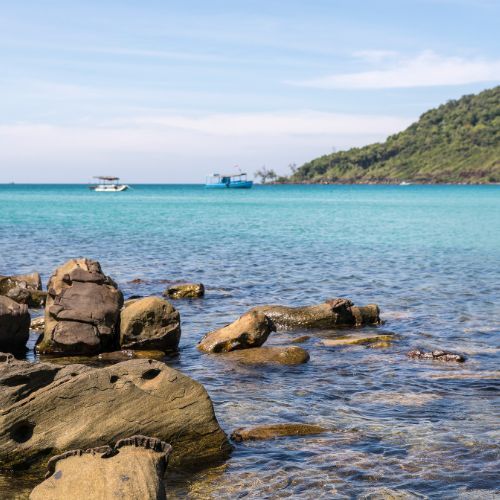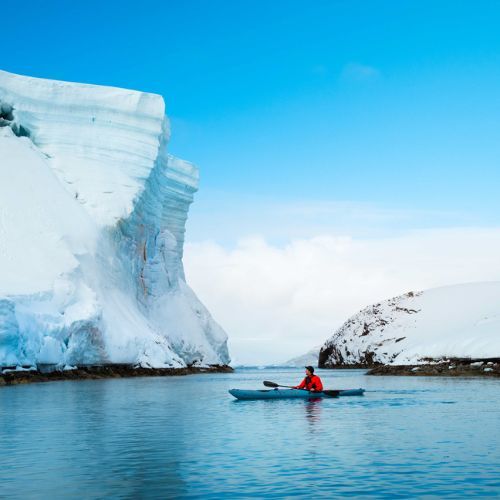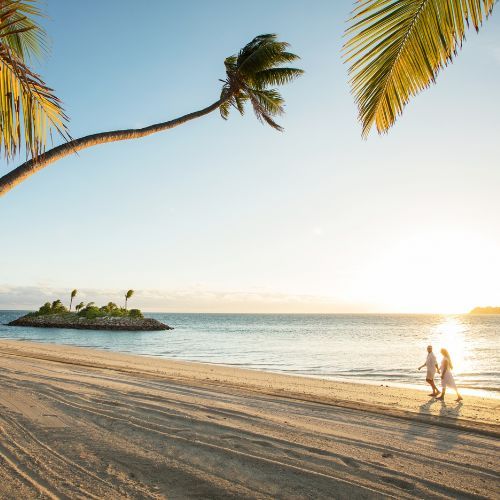
If small-town surfing center Siargao island isn’t already on your radar, it will be very soon. Jeninne Lee-St. John propellers out to the eastern edge of the Philippines, where hand-woven hammocks hang on still-empty sands, laissez-faire beach life sets the tone at bars, in boutique hotels and on the breaks—and the pacific currents roll in uninterrupted.
“I’M HAVING HEART PALPITATIONS,” I said to Scott, my photographer pal I was traveling with, as we sat down to a lunch spread of chicken, grilled fish, and bowls of whole grains and veggies. “Are you OK?” he put his fork down, concerned. I looked at the white-ringed pool straight out of Santorini surrounded by woven daybeds and leaf-shaped loungers, and the green-green lawn dotted with oversized four-poster beds and palm trees with swinging pods in the form of teardrops. The wide beach and the shallows stretched beyond, containing what looked like a gazebo about 800 meters offshore and a distant sandbar out in the middle of the horizon. The skies were clear, my chair was facing the sun and I had just been handed a fresh coconut spiked with spiced rum.
[gallery ids="6917,6918"]I was more than OK. I was in a paradisiacal dream and I was terrified I wouldn’t have enough time to enjoy it all before I woke up.
We were having our first meal in Nay Palad Hideaway, a boutique beach resort on Siargao Island, at the eastern edge of the Philippine archipelago. I’d been trying to get here for years. A big part of the appeal has been that it isn’t anywhere close to easy-access. You can only fly via Manila or Cebu, and six-plus-hour layovers have a way of keeping places off the international-weekend-jaunt map.

Siargao, in Surigao del Norte province, sits just above breadbasket Mindanao but is far removed from any of the conflicts that have plagued that larger island. Its natural beauty attractions are akin to those you may have heard of in Palawan: rock pools, underground caves, limestone cliffs. But Siargao’s real draws are the seclusion, the social life, and the surf. It is a favored weekend getaway for those from Manila, who come to stay in the chill beach-shack hotels, hang in the laidback bars and restaurants lining the main strips, and to zone out on the empty beaches. At the same time, as the direct recipient of uninterrupted Pacific currents and winds, the island is the surfing capital of the country. With consistent long rolling tubes, Cloud 9 is the most famous break, but there are sundry others. By simply typing those two sentences I’ve earned the ire of loads of surfers worried about the wider world discovering their seaside secret.
In fairness, the concern is increasingly valid. This year Cebu completed a renovation of its international terminal; in Siargao there are plans to expand the airport and they’ve already begun widening the road that connects it to the main tourist hub of General Luna—construction that accounted for the only traffic we saw the whole trip. With Nay Palad, by far the island’s most luxurious resort, having just completed a rebranding that included adding a stunning three-bedroom villa that starts at US$3,300 per couple per night, how long can the island hold off other developers trying to ride a tourism tide?
[gallery ids="6923,6924"]Southeast Asia is scattered with plenty of tiny destinations accessible only by prop plane, but once you walk across the tarmac into most of those airports you wind up in a room containing a little baggage carousel. When I touched down in Siargao, I walked into essentially a loading dock in which arriving passengers waited for airline workers to deposit our bags directly at our feet. Bus-terminal chic. Yes, this was still off the grid. I was overjoyed.
In a happy coincidence, Scott and I had booked our trip during a time that overlapped with a wedding some of my friends from Manila were attending. Our first night, we flagged a habal-habal—a motorbike taxi with an elongated backseat—to meet my friend Steph and her husband Jonathan at a Basque-themed beach club called Bravo in General Luna. We found them having tapas at a long table by the pool. Even after dusk it was sweltering. We cooled down with glasses of Pinot Grigio loaded up with ice cubes.
Persuaded to go to the full-moon party, we piled into a tricycle to a beach bar named Palaka that, by day, serves as a dive center. The beach, which I would later learn is the main dock by the central market, was filled with girls with bikini strings poking out of their tops and guys with long hair in board shorts, all clutching San Miguels as house music pumped. The word that might come to mind in such a scenario is “sketchy” but it wasn’t actually that at all. It was more like a high school dance… with a fire show. Siargao may be a surf center but its popularity is relatively recent. There remained an air of innocence about the party that was of a piece with the overall vibe of the island.
[gallery ids="6921,6922"]It was a vibe I bought into fully when the smiling bar cashier nudged her plate of hot, hand-cut french fries at me. Who can resist hand-cut french fries from a stranger?
While I was blabbering about how wholesome and friendly Siargao had already proven itself to be, we got in another tricycle, this one prepped for a party: flashing lights, disco balls. We asked cheekily if we could pick the music and the driver handed over a plug for a phone jack. We wrapped up the night at inside-outside pool hall Loose Keys. Our friends Aziza and Allana were passing and they popped in to say hi. It was as if the gods had conspired to meet all my small-town expectations in one night.
Flopped Alice-style on a double-size, double-high Wonderland bed, contemplating the position of the sun and just how I was going to allocate my lounging time between our vast villa and the rest of the resort, which we basically also had all to ourselves, I heard my phone ring. It was Steph. “The wedding reception is at the next hotel over from yours,” she said. “We can come early and walk down the beach to you.”
“Uh, no, you can’t,” I said, glancing skeptically northward, where waves were lapping up at a promontory of trees that marked Nay Palad’s property line.
“Sure,” she said. “It’ll be fine.”
The change of tide here is dramatic, and was made all the more so during our visit by the full moon. The vast flats at low tide reminded me of a children’s book I used to love in which the main character has the ability to swallow the sea, and does so reluctantly to help a little boy pluck fish off the ocean floor. The ungrateful kid doesn’t come back when he’s called, so the hero runs out of breath, has to spit out the water, and drowns the boy. When I told Scott this story, he said it didn’t sound like a good book for kids.
It wasn’t, but let’s just say the moral of that story was supposed to be that the ocean floor is full of peril. A visit to Cloud 9 will tell you that. The iconic wave breaks over a reef so far offshore they built a 200-meter boardwalk to reach it. A staircase descends into the ocean at standing depth, and you still have to paddle out from there. From the third floor of the viewing tower, a tourist destination in its own right, it looks, I was told, like a perfect line of beauty. Facing it from the water, it’s a thick hollow tube that looks consistent and seems like it should be easily readable (by my instructor, I mean; I’ve only surfed like 10 times). But it also rolls in on what I’ll call the Siargao flats—long, reef-bottomed shallows that can cut you up big time. I had two fist-pumpingly fun lessons, but I definitely would have been in and out if I weren’t wearing a pair of neoprene sport socks. It’s crystal clear why they say this wave at its lowest is definitely not at its safest.

So, Steph, of course, was right: here in Siargao all that matters is watching the tide. By the time their paraw pulled up to Nay Palad a couple of hours later, the water had receded so much that they actually had to disembark a bit offshore. No neoprene or fish plucking for them, she and Jonathan strolled up smiling. On the property’s west side, a boardwalk winding through a mangrove forest filtering unbelievable magic-hour light brought us to the private three-story pier. Our beloved girl Friday, Flo Flo, followed with a cold bottle of Kiwi Sauvignon Blanc and a platter of canapés, and we sat in swings as the sun faded. We chatted about how the wedding had been on Naked Island, the large empty sandbar offshore where Scott had done a sun-beaten photo shoot a decade earlier. Back then, he said, most of the hotels and bars we’d seen in General Luna the night before were just palm groves.
The following morning we found ourselves back at the pier. Nay Palad has five of their own boars, and the star is a plush, custom-built yacht capable of navigating the twice-daily low waters of the mangrove channel in which it docks. We cruised out the kill, passing a village in front of which tiny kids were splashing in the shallows. Here I should point out that I know a tropical island is the last place you’re supposed to care about the Wi-Fi. Digital detox. Be present. All that, yes. But sometimes you need to, say edit stories, or upload your pics to the cloud… or to your social media so everyone can see how awesome your job can be. Nay Palad is in a section of Siargao tucked under a mountain. They’re building their own cell tower but, when we were there, the signal on-site was spotty. We had no choice but to embrace a de facto disconnection.
Nearly a kilometer out at sea, though, every phone on the boat started pinging. We were pulling physically farther from civilization while the reappearance of the Internet was pushing us virtually closer to the world. Full service imparted a weird feeling of relief and reluctance. Once Scott and I got our WhatsApp and Instagram fixes, we tucked our phones back away to devote our attention to the placid seas, the lush islands in the distance in every direction, the fishing boats we occasionally slowed down to pass. We wondered if building that tower was going to wind up helping to ruin the reverie.
[gallery ids="6925,6926"]After about an hour, we pulled up to a little spit of sugar sands ringing a hill of thin forest. The water shimmered Tiffany-box blue speckled with seaweed-covered coral. I wanted in ASAP, but the staff were all readying our supplies to take ashore. It was caravan by paddleboard: beach chairs, bags of towels, tableware, coolers filled with wine and beer and lunch fixings, and a barbecue grill were loaded atop fat paddleboards and floated to the beach. As soon as they were done, I hopped on one and set about exploring our surrounds. Watching schools of fish darting through the transparent water, I could see why the strait between Mamon, where we were docked, and La Janoza across the way is a coveted snorkeling spot.
It seemed an inordinate number of paraws had begun to arrive at Mamon—with chickens. I joked to our guide that they were probably going to eat them, and he said, “Sometimes, but only if you’re immune to the poison.” It turned out there was a secret cockfighting ring on this island, and some owners dab poison on their talons to give their birds an edge. It was Sunday. “The women go to church,” our guide said, “and the men can go to the fight.”
I admired the litter of outriggers they left behind on the beach—a jellybean basket of empty boats, the perfect cliché Philippine island photo if there ever was one—from the gazebo our five minders had rendered five-star for us, laying out a woven tablecloth covered with grilled shrimp, fish and chicken, carrot salad, fried rice, fruit and a pile of coconut chocolate-chip cookies Scott went bonkers for. The sunglasses-wearing chef tossed a wok of noodles over the fire and my heart melted a little, reminding me why I love living in Southeast Asia, this DIY, tradition-blending, just-figure-out-how-to-get-it-done attitude.
It’s a mindset we saw in full-force on a very different afternoon, when Nay Palad was putting on a spaying and neutering clinic in a nearby village (where they also sponsor the elementary school). They had flown in a few veterinarians from Manila, put them up at the resort, and put the word out across the island to bring their cats and dogs to get fixed. Those without a vehicle just had to call, and Kate, the resort’s bubbly, American, management trainee, would fetch the animals in her cartoonish big red dune buggy. I later learned that among the resort owners’ other projects is Compostela, a sustainable rainforest village they built for 500 former scavengers who used to live on a dumpsite in Cebu City.
Knowing about this community stewardship goes a ways towards offsetting the guilt of staying somewhere with such a high room rate. So does the fact that the resort is all-inclusive from food and beverage to day trips (a good pick is a sail to the karst-ringed, emerald-pooled Sohoton Cove, accessible only through a hole in a rock when the tide ebbs). It is assumed you will treat the property like home. If you want a drink and there’s no bartender, just head back and pour it yourself; if you want to watch a movie under the stars, the staff will string a screen between the palm trees. Airport pick-ups are in a comfortably kitted out, couch-lined antique jeepney. The spa is set up like a fairy village, and once you put on their bespoke Turkish-towel, hoodied and tassled bathrobe, you’re not going to want to take it off. (I, in fact, spent half my trip in one. An overpacker in the best of times, I found myself with three times as many clothes as I needed.)

They manage this level of service by limiting the number of villas occupied by separate parties to six. And in truth, the villas alone offer enough distraction by sheer will of their playful, tasteful luxury. Scott and I were able to share the new three-bedroom pad—complete with firepit, tree house and porch swing—because there were two master bedrooms, both facing the private pool and the beach, and both with giant bathrooms whose ceilings were half given over to massive rain showerheads, putting to shame anyone else’s definition of rain shower ever.
Not until we were nearly done planning this trip did I realize Aziza runs a travel agency that specializes in Siargao. I just thought she was being friendly. But she organized the wedding everyone was in town for, and besides spending her childhood here on holiday, her ties to the island stretch back generations. She emphasized how committed she and other Siargao boosters are to not letting the island become another Boracay—encouraging developers to have proper irrigation solutions before they build, tourists to participate in organized beach cleanups and volunteers to support Nature Kids of Siargao, which helps residents upcycle and live more sustainably.
One evening, she picked up Scott and me in a paraw bearing her name, and her boatman motored us across the strait to Daku Island. It has a curve of beach facing west to Siargao that is a favored spot for sunset-seekers. Sitting in the sand, we caught the last rays of the day, then walked through the village, amid the competing din of several convenience stores-cum-karaoke huts. Aziza’s mom was on the porch and, though she wasn’t expecting us, she smiled knowingly, as if her daughter brought back random stragglers to enjoy her hospitality regularly. She told us that she, too, had grown up coming to these islands, her father having served three terms as a congressman for the area. When they built this house in the 1990s, the family slept on mattresses on the floor, and had no electricity, only turning the generator on at night. Her kids plucked sea urchins off the beach, fish from the ocean floor.
[gallery ids="6927,6928"]During a lull in the waves on my second morning out on Cloud 9, I had a couple of minutes to stop being out of breath and actually contemplate the island in front of me. Would this wave that made the place famous contribute to its undoing? The cool kids have been deriding it as “Crowd 9” for a while. Certainly, I wasn’t supposed to be out here, but the locals had a system. The real surfers stick to the bigger side of the break. Beginners head to the other side where instructors can control your boards and chat with each other over your heads like parents minding kids on the playground. If my teacher, Doy Doy, changed his mind about whether I should try to catch a wave, he’d just pull back my leash and resume scanning the horizon for the next one. The mood on the water was convivial, there was an etiquette. “Ladies first!” he’d shout to call dibs on a wave for me, and “last wave!” to signal it was my final ride of the day, so everyone get out of the way, thank you very much.
I guess I didn’t embarrass Doy Doy on day one, because for this second lesson, he put me on a shorter board than I’d ever ridden. When he called out “last wave”—even though I had told him to—my heart broke a bit, since it was also our last day in Siargao, and we’d be heading to the airport soon. Aziza met us at the pier to say goodbye. She and Kate had become pals during our visit, and they were having lunch. During our six-hour layovers in Cebu, they sent Scott and me photos of their wholesome island day, and said they were en route to Daku so Aziza could introduce yet another straggler to her mama. We sighed. At least someone was still living the paradisiacal dream.
SIARGAO
With the lengthy layovers, it’s not a quick trip to Siargao from overseas. Allot two days of travel time plus at least four full days there to really get into the island vibe.
GETTING THERE
Fly into Manila or Cebu, then catch a regular PAL Express or CebGo connection to General Luna; SkyJet runs flights between Manila and General Luna five days a week. Rainy season starts in January; typhoon season is February and March. The best surfing is September to November.
STAY
Nay Palad Hideaway

The top accommodation in Siargao is the playful, relaxed epitome of rustic-chic barefoot luxury. There are just nine one- and two-bedroom villas with fun touches like rocking horses and porch- swings, plus one brand-new three-bedroom villa that features a pool, a projection screen in the kids’ room and its own firepit. Rates are all-inclusive of food, beverages, spa treatments, use of the resort’s private boats, various excursions including island-hopping and surfing lessons, activities such as yoga and watersports, and round-trip airport transfers.
naypalad.com; from US$630 per person per night.
TOUR
Destino Luxe Travel and Tours A boutique agency with a personal dedication to responsible tourism in Siargao. They can book your entire itinerary, or just one-off day trips or excursions—and recommend ways to give back.
destinoluxe@gmail.com; call James at +63 977 651 5397.
Photos by Scott A. Woodward, unless otherwise noted.


